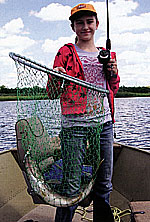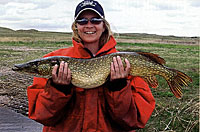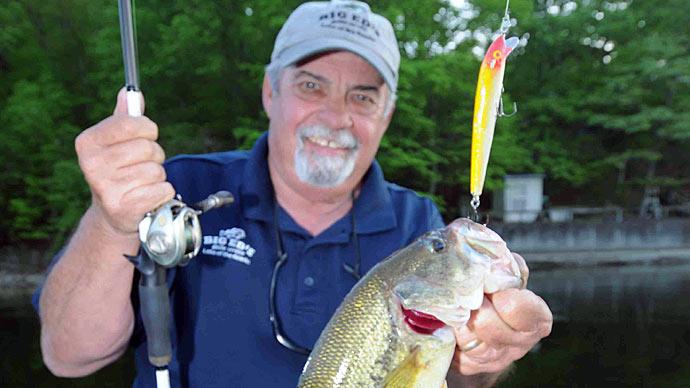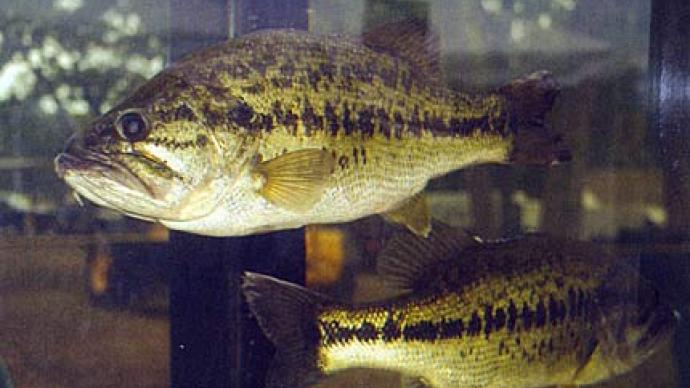
Pond fishing. What does that conjure up in your mind? For most people in the USA, pond fishing usually means largemouth bass and bluegill. However, what about folks in the northern part of the country? In many such locations, walleye is king (queen is probably a bigger term, as most of the bigger walleyes are females). Here is a list of fishes considered to be more northern in distribution. How might they be useful in pond management?
Walleye
Is the walleye a sport fish, or just a swimming fillet? I guess the answer doesn't matter to pond managers -- many northern pond owners simply want the walleyes in their ponds. Traditional advice has been to not use walleyes in small ponds because they typically won't reproduce. However, we have observed a small amount of successful reproduction in some of our larger ponds - those of 15 to 25 acres. It's probably not enough to support a harvestable population, but it does maintain the species. Some wave-washed rock or gravel habitat on a dam or a long "point" in the pond is needed for reproduction.
The best advice is to use walleye as a "bonus" species in a pond. Perhaps you are managing a largemouth bass-bluegill combination. In such a situation, walleyes can be a bonus predator. Maintenance stockings will be required to maintain stocks. How many you stock will depend on how many you want to harvest when they grow large enough. Larger sizes of walleye fingerlings are necessary for stocking ponds with established fish communities. Most suppliers can provide 6-8 inch walleyes by the first fall of the walleye's life. Consider stocking 10 per acre each year, and adjust up or down depending on observed survival and the amount of harvest planned.
Smallmouth bass

Is there any pond fish more fun than a smallmouth bass? Nothing fights like a smallie! Who wouldn't want them in a pond? My personal northern bias is showing, isn't it?
Smallmouths do well in northern ponds. While they do not always naturally reproduce well in southern ponds, such has not been a problem in northern ponds. In fact, they have a tendency to overpopulate and stunt in northern waters.
A safe management strategy is to use smallmouth bass alone in a northern pond, or perhaps with golden shiners as a prey source. Certainly, you can stock fathead minnows at the same time as you introduce smallies, but don't expect the fatheads to last more than a year or two. They will be quickly gobbled up by hungry bass. In most northern ponds, maintain substantial harvest of smaller smallmouth bass to prevent overpopulation and stunting. Once a smallmouth bass population is established and reproducing well, perhaps 4-5 years after initial introduction, consider harvesting a large proportion of the 12 inch and smaller bass. That strategy will keep down population density, nudge growth rates upward and maintain the production of those 15-20 inch smallies we are striving to grow. This is a safe management strategy, as it will be nearly impossible to harvest too many of the small fish. Only a few survivors are needed to grow to larger sizes and replace bigger fish that die of natural mortality. While it makes traditional bass anglers cringe, smallmouth bass provide good, white fillets. Selective harvest can maintain and promote quality-size smallmouth bass in a pond.
At this time, I cannot recommend using smallmouth bass as a predator to control panfish species in a pond. The smallmouth bass just does not have the same predatory capability as largemouth. This subject has not been thoroughly investigated.
Consider a 3-acre pond that has about 25% coverage of submergent aquatic plants during midsummer. If you put smallmouth bass and bluegill, or smallmouth bass and yellow perch, into that pond, the panfish species will overpopulate and stunt. The question arises in clear-water sand and gravel pits, or perhaps in clear ponds with lots of rocky habitat and few plants. In such waters, smallmouth may indeed be able to control excess panfish reproduction. We honestly don't know the answer to that question. If you try such a strategy, be sure to consider it experimental - it may not work ... but let us know. We are in the research business, you know?
Largemouth bass and bluegill?
Why would I include largemouth bass and bluegill in a list of northern fishes? Well, perhaps some of you have heard that the largemouth bass-bluegill combination doesn't "work" in northern ponds? Well, don't believe that for a second! It works, and it works well. I would caution that producing true trophy bass is difficult in northern ponds. I'd suggest trophy largemouths in the north to be those about 5 pounds or so.
The other part of the potential for largemouth bass and bluegill is to produce big bluegills. Just as in other parts of the USA, a high density of small (most less than 12 inches long), hungry largemouth bass will effectively crop reproduction by bluegills. As a result, there are fewer bluegills, more food per individual, and you can produce those 8, 9 and even 10+ inch bluegills.
Northern pike

Northern pike - the water wolf. It seems like most anglers either love 'em or hate 'em. They certainly can be fun sport fish, and those fillets are firm and white, once you learn how to get rid of that extra y-bone. Watch out for all those teeth when you unhook one of them!
Traditional advice has been to leave northern pike out of the pond stocking combination. They can eat you out of house and home. Northern pike prefer prey items that are 33-40% of their body length, so an average size, 24-inch northern pike likes to eat 8- to 10-inch yellow perch. The pike actually compete with anglers for those harvestable-size panfish we love to catch.
There is a nontraditional use for northern pike in ponds. Consider a pond with a high density of small largemouth bass that big quality bluegills. As discussed earlier, few bass will exceed 12 inches in length under such a management strategy in northern ponds. A moderate number of northern pike will actually help thin the bass by preying on those less than 12 inches long, and the remaining bass will grow larger. At the same time, bluegill quality typically will stay high. Sounds like a can't-lose situation, doesn't it? Well, it is a good situation unless the northern pike reproduce and survive so well that they get to a high abundance and become the dominant predator. One thought might be to introduce only adult northern pike of one gender. Perhaps you want to introduce three or four female northern pike (it's easy to tell gender during spring spawning season for pike) in a 2- or 3-acre pond. They'll live several years, and you'll need to add one or two every few years. Such a strategy could provide both good bass fishing and good bluegill fishing, plus just think of the squeals when one of the kids or grandkids hooks an 8-pound northern pike!
Yellow perch

Largemouth bass love to eat yellow perch. Why? Well, consider their fusiform (torpedo-shaped) body form in relation to a fish such as the bluegill, which has a compressed body form. That torpedo shape is certainly easy to handle and swallow.
We have managed South Dakota ponds with the largemouth bass-yellow perch combination for years, in waters ranging from a couple acres to over 50 acres. Much like the bass-bluegill combination above, a high density largemouth bass population will thin the reproduction by yellow perch and keep them from overpopulating. Expect to produce 10- to 12-inch yellow perch under such a management strategy in fertile Midwestern ponds.
A few cautions are probably in order. Pond Boss Forum moderator and guru Bill Cody has encountered problems with a largemouth bass and yellow perch combination in small ponds (say a half acre or less). Yellow perch can be much more piscivorous (those fish-eating little rascals) than other panfish such as the bluegill and have their own influence on a pond fish community. As a result, Bill much prefers to use yellow perch alone in small ponds, and feed them a pelleted ration. If they get overly abundant and stunt, then they can be seined or netted from such small ponds to reduce their density. Look for Bill to talk more about this strategy in future Pond Boss issues.
Pumpkinseed
What a gorgeous little fish! Can pumpkinseeds be included in a pond management strategy? Certainly! Be aware their reproductive capabilities are much like bluegill. You'll need a predator to keep them in check. A high density of small largemouth bass will do the trick for you. Expect to produce 8- to 8.5-inch pumpkinseeds in such a pond. I would be more tempted to use pumpkinseed along with another panfish (perhaps bluegill or yellow perch) in a northern pond. A high density largemouth bass population will keep both of your panfish species in check. By the way, pumpkinseeds, like their southern cousin the redear sunfish, can feed on snails. Snails are part of that complex cycle for pond fish parasites such as yellow grub and black spot, and perhaps (no hard evidence to date) the pumpkinseeds could help reduce the incidence of those parasites?
So, there you have it. Common northern fishes, and their uses in northern ponds. Most pondmeisters seem to enjoy a little diversity these days, and you certainly can use this list of fishes to provide diversity in a pond.
Dave Willis is the Department Head in the Department of Wildlife and Fisheries Sciences at South Dakota State University.
Reprinted with permission from Pond Boss Magazine



